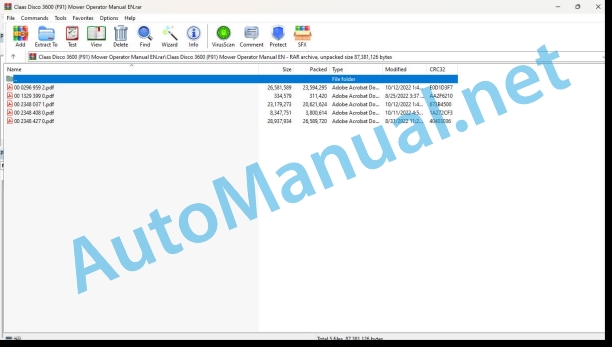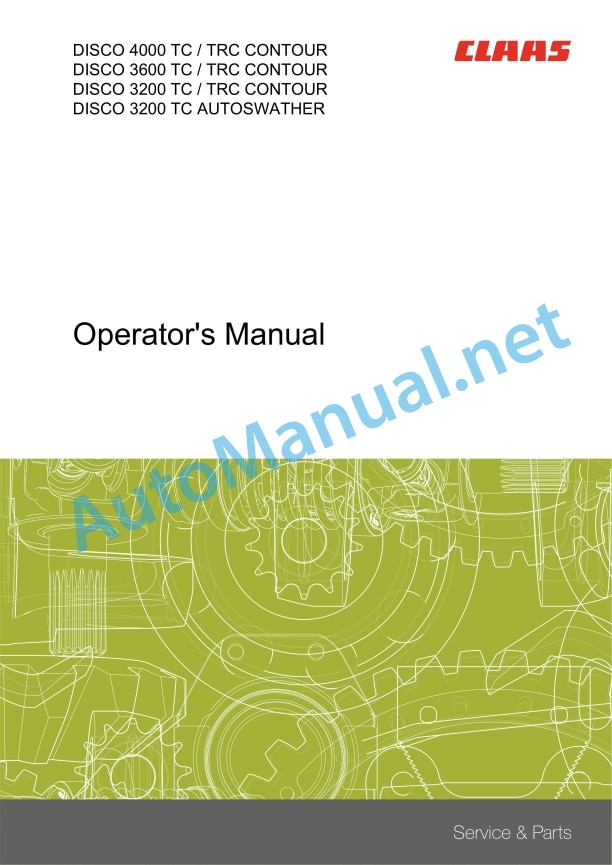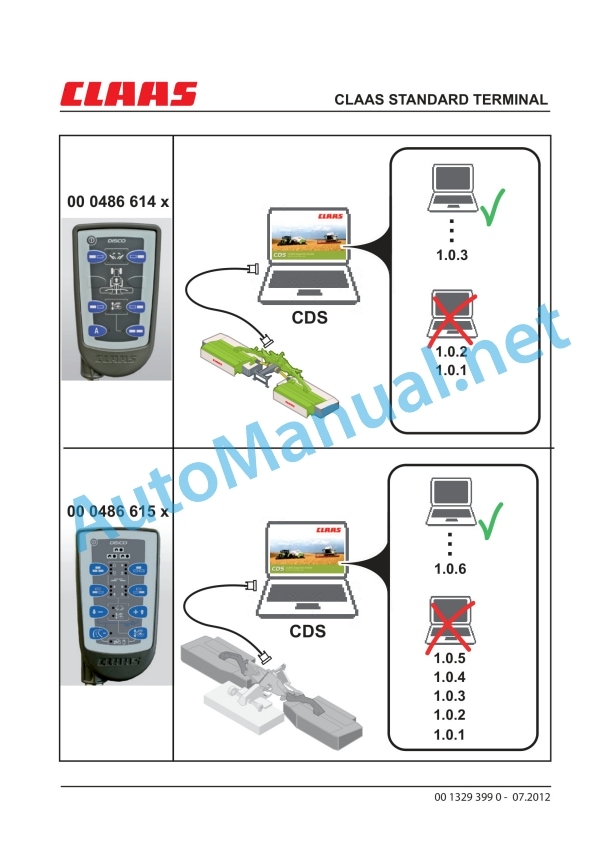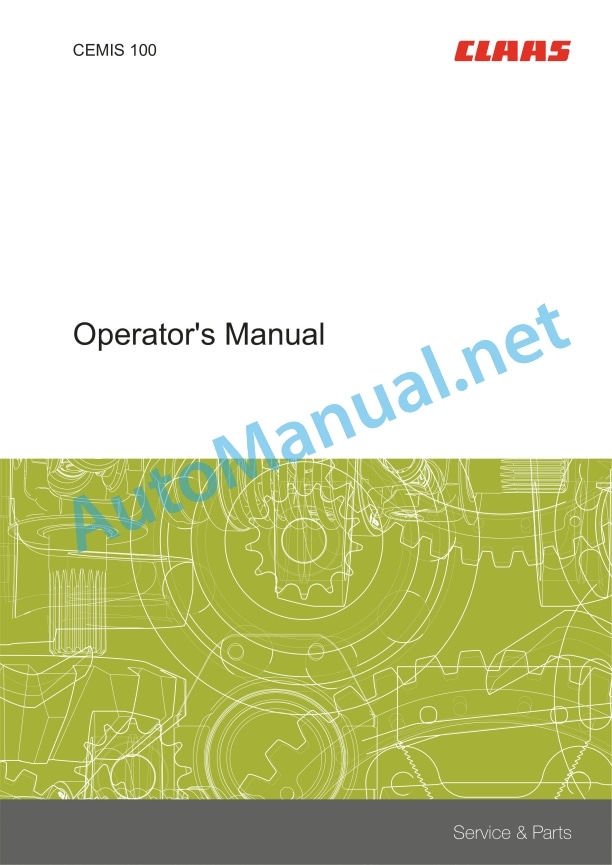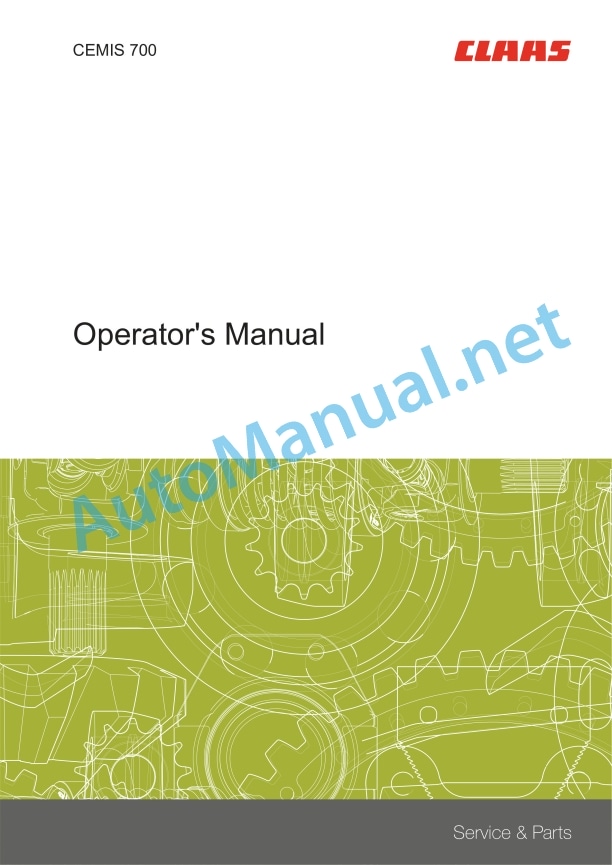Claas Disco 3600 (F91) Mower Operator Manual EN
$50.00
- Model: Disco 3600 (F91) Mower
- Type Of Manual: Operator Manual
- Language: EN
- Format: PDF(s)
- Size: 71.4 MB
File List:
00 0296 959 2.pdf
00 1329 399 0.pdf
00 2348 037 1.pdf
00 2348 408 0.pdf
00 2348 427 0.pdf
00 0296 959 2.pdf:
DISCO 4000 TC / TRC CONTOURDISCO 3600 TC / TRC CONTOURDISCO 3200 TC / TRC CONTOURDISCO 3200 TC AUTOSWATHER
Table of contents
1 Introduction
1.1 Notes on the manual
1.1.1 Validity of manual
1.1.2 Information about this Operator’s Manual
1.1.3 Symbols and notices
1.1.4 Optional equipment
1.1.5 Qualified specialist workshop
1.1.6 Notes on maintenance
1.1.7 Notes on warranty
1.1.8 Spare parts and technical questions
1.2 Intended use
1.2.1 Intended use
1.2.2 Reasonably foreseeable misuse
2 Safety
2.1 Identifying warnings
2.1.1 Hazard signs
2.1.2 Signal word
2.2 Safety rules
2.2.1 Importance of Operator’s Manual
2.2.2 Observing safety decals and warnings
2.2.3 Requirements for all persons working with the machine
2.2.4 Children in danger
2.2.5 Hazard areas
2.2.6 Staying between the tractor and the machine
2.2.7 Hitching the tractor to the machine
2.2.8 Risk of injury from rotating shafts
2.2.9 Structural changes
2.2.10 Optional equipment and spare parts
2.2.11 Control of the machine while it is running
2.2.12 Only use once properly put into operation
2.2.13 Technical condition
2.2.14 Danger due to damage to the machine
2.2.15 Respecting technical limit values
2.2.16 Danger from machine parts running on
2.2.17 Keeping protective equipment functional
2.2.18 Personal protective equipment
2.2.19 Wearing suitable clothing
2.2.20 Removing dirt and loose objects
2.2.21 Preparing the machine for road travel
2.2.22 Hazards when driving on the road and in the field
2.2.23 Parking the machine safely
2.2.24 Unsupervised parking
2.2.25 Unsuitable operating materials
2.2.26 Safe handling of operating and auxiliary materials
2.2.27 Environmental protection and disposal
2.2.28 Lethal electrocution from overhead lines
2.2.29 Behaviour in case of voltage flash-over from overhead lines and when lightning strikes
2.2.30 Noise may cause health damage
2.2.31 Liquids under pressure
2.2.32 Hot surfaces
2.2.33 Only carry out work on the machine when it is stopped
2.2.34 Maintenance operations and repairs
2.2.35 Lifted machine parts and loads
2.2.36 Danger from welding work
2.3 Safety marking
2.3.1 Layout of safety decals
2.3.2 Safety decals on the machine
3 Machine description
3.1 Overview and method of operation
3.1.1 Overview of DISCO 4000 TC / 4000 TRC / 3600 TC / 3600 TRC / 3200 TC / 3200 TRC
3.1.2 Overview of DISCO 3200 TC AUTOSWATHER
3.1.3 Overview of the cutting disc direction of rotation
3.1.4 Function of DISCO 4000 TC / 3600 TC / 3200 TC
3.1.5 How the DISCO 4000 TRC / 3600 TRC / 3200 TRC works
3.1.6 Function of DISCO 3200 TC AUTOSWATHER
3.2 Optional equipment
3.2.1 High-cut skids*
3.2.2 Double high-cut skids*
3.2.3 Wear skids*
3.2.4 Bar protection*
3.2.5 Slip-on yoke for 8-piece universal drive shaft*
3.2.6 Slip-on yoke for 21-piece universal drive shaft*
3.2.7 Hydraulic system connectors, 3-fold*
3.2.8 Crop spreader*
3.2.9 Swathing plate extension*
3.2.10 Hydraulic system connectors, 3-fold*
3.2.11 Wheel weights*
3.2.12 Toolless drawbar adjustment*
3.2.13 Legal equipment for France*
3.2.14 SMV triangle*
3.3 Identification plate and vehicle identification number
3.3.1 Spare parts and technical questions
3.3.2 Machine identification plate
3.4 Information on the machine
3.4.1 Stickers on the machine
3.4.2 Information on the machine
4 Operating and display elements
4.1 Controls
4.1.1 Hydraulic hose line
4.1.2 Mower unit
4.1.3 Cross conveyor belt
4.2 Display elements
4.2.1 Pressure gauge
5 Technical specifications
5.1 DISCO 4000 TC
5.1.1 Dimensions
5.1.2 Weights
5.1.3 Requirements on the tractor
5.1.4 Version
5.1.5 Tyre size
5.1.6 Tyre pressure
5.1.7 Sound pressure level
5.1.8 Lubricants
5.2 DISCO 4000 TRC
5.2.1 Dimensions
5.2.2 Weights
5.2.3 Requirements on the tractor
5.2.4 Version
5.2.5 Tyre size
5.2.6 Tyre pressure
5.2.7 Sound pressure level
5.2.8 Lubricants
5.3 DISCO 3600 TC
5.3.1 Dimensions
5.3.2 Weights
5.3.3 Requirements on the tractor
5.3.4 Version
5.3.5 Tyre size
5.3.6 Tyre pressure
5.3.7 Sound pressure level
5.3.8 Lubricants
5.4 DISCO 3600 TRC
5.4.1 Dimensions
5.4.2 Weights
5.4.3 Requirements on the tractor
5.4.4 Version
5.4.5 Tyre size
5.4.6 Tyre pressure
5.4.7 Sound pressure level
5.4.8 Lubricants
5.5 DISCO 3200 TC
5.5.1 Dimensions
5.5.2 Weights
5.5.3 Requirements on the tractor
5.5.4 Version
5.5.5 Tyre dimensions
5.5.6 Tyre pressure
5.5.7 Sound pressure level
5.5.8 Lubricants
5.6 DISCO 3200 TRC
5.6.1 Dimensions
5.6.2 Weights
5.6.3 Requirements on the tractor
5.6.4 Version
5.6.5 Tyre dimensions
5.6.6 Tyre pressure
5.6.7 Sound pressure level
5.6.8 Lubricants
5.7 DISCO 3200 TC AUTOSWATHER
5.7.1 Dimensions
5.7.2 Weights
5.7.3 Requirements on the tractor
5.7.4 Version
5.7.5 Tyre dimensions
5.7.6 Tyre pressure
5.7.7 Sound pressure level
5.7.8 Lubricants
6 Machine preparation
6.1 Switching off and securing the machine
6.1.1 Switch off and secure the tractor and machine
6.1.2 Securing the raised machine
6.2 Accessing workplaces and maintenance places
6.2.1 Opening and closing the safety device
Folding up the front safety frame
6.3 Adapting the machine
6.3.1 Universal drive shaft – checking the length
6.3.2 Adapting the length of the universal drive shaft
6.3.3 Fitting the universal drive shaft to the machine
6.3.4 Attaching the double high-cut skids*
6.3.5 Installing the high-cut skids*
6.3.6 Removing the high-cut skids*
6.3.7 Installing wear skids*
6.3.8 Adapting the lateral offset
6.3.9 Adapting the lateral offset without tools*
6.3.10 Adjusting the ground clearance of the cross conveyor belt
6.4 Hitching the machine
6.4.1 Hitching up the hitching bracket
6.4.2 Swinging up the stand
6.4.3 Installing the universal drive shaft
6.4.4 Connecting the hydraulic hose for lifting
6.4.5 Attach the hydraulic hose connections for load relief
6.4.6 Connecting the hydraulic hose for slewing
6.4.7 Connecting the hydraulic hose for the cross conveyor
6.4.8 Connecting the lighting cable
6.4.9 Connecting the cross conveyor control panel
6.5 Unhitching the machine
6.5.1 Removing the cross conveyor control panel
6.5.2 Swinging the stand down
6.5.3 Unplugging the lighting cable
6.5.4 Disconnecting the hydraulic hose for the cross conveyor
6.5.5 Disconnecting the hydraulic hose for slewing
6.5.6 Detach the hydraulic hose connection for the load relief
6.5.7 Disconnecting the hydraulic hose for lifting
6.5.8 Removing the universal drive shaft
6.5.9 Unhitching the hitch bracket
6.6 Prepare road travel
6.6.1 Lowering the cross conveyor belt to transport position
6.6.2 Lifting the mower unit
6.6.3 Slewing to transport position
6.6.4 Closing shut-off taps
6.6.5 Folding up the safety frame
6.7 Preparing the working position
6.7.1 Folding to working position
6.7.2 Lowering the mower unit
6.7.3 Folding down the safety frame
6.8 Loading the machine
6.8.1 Lifting the machine
7 Operation
7.1 General safety precautions
7.1.1 Prior to operation
7.2 Driving on the road
7.2.1 Driving on public roads
7.2.2 Marking the machine for road travel
7.3 Fieldwork settings
7.3.1 Adjusting the drawbar height
7.3.2 Adjusting the mower unit load relief
7.3.3 Overview of balancing pressure settings
7.3.4 Adjusting the cutting height
7.3.5 Adjusting the conditioner speed
7.3.6 Adjusting the tine conditioner
7.3.7 Adjusting the roller conditioner
7.3.8 Adjusting the swathing width
7.3.9 Adjusting the crop spreader*
7.3.10 Adjusting the conditioner discharge flap to the cross conveyor belt
7.3.11 Adjusting the throwing width of the cross conveyor belt
7.4 Fieldwork
7.4.1 To be observed during fieldwork
7.4.2 Machine use
7.4.3 Adapting the PTO speed
7.4.4 Mowing methods
7.4.5 Mowing with the cross conveyor belt
Mowing with cross conveyor belt and without front mower unit
Mowing with cross conveyor belt and front mower unit
7.4.6 Lowering the cross conveyor belt down to working position
7.4.7 Operating the cross conveyor belt
7.4.8 Lifting the machine to the headland position
7.4.9 Instructions for mowing
7.4.10 Difficult operating conditions
7.4.11 Recommendation for environmental protection
8 Faults and remedies
8.1 Overview of problems
8.1.1 Problems on the machine
8.2 Electric system
8.2.1 Light bulb faulty
8.3 Chassis
8.3.1 Change the transport chassis wheel
8.4 Mower unit
8.4.1 The cutting disc no longer turns
9 Maintenance
9.1 Service interval overview
9.1.1 Before the harvest
9.1.2 After the first 10 operating hours
9.1.3 After the first 50 operating hours
9.1.4 Every 8 operating hours
9.1.5 Every 20 operating hours
9.1.6 Every 50 operating hours
9.1.7 Every 100 operating hours
9.1.8 Every 250 operating hours
9.1.9 Every 500 operating hours or annually
9.1.10 Every 5 years
9.1.11 After the harvest
9.2 Gearbox
9.2.1 Checking the gearbox for leaks
9.2.2 Checking the oil level in the main gearbox
9.2.3 Topping up the main gearbox oil
9.2.4 Changing the oil in the main gearbox
9.2.5 Checking the oil level in the transfer gearbox
9.2.6 Topping up transfer gearbox oil
9.2.7 Changing the transfer gearbox oil
9.2.8 Checking the oil level in the angle drive
9.2.9 Topping up the angle drive oil
9.2.10 Changing the oil in the angle drive
9.3 Clutch
9.3.1 Check the overload clutch
9.3.2 Venting the friction clutch
9.3.3 Checking the friction plates
9.3.4 Cleaning the universal drive shaft friction clutch
9.4 Universal drive shaft
9.4.1 Servicing the universal drive shafts
9.5 Chassis
9.5.1 Checking the tyre air pressure
9.5.2 Retightening the wheel nuts on the transport chassis
9.6 Hitch
9.6.1 Adjusting the pressure springs
9.7 Hydraulic system
9.7.1 Checking the hydraulic hoses
9.7.2 Checking the pressure accumulator
9.7.3 Tensioning the hydraulic pump drive belt
9.7.4 Changing the hydraulic pump drive belt
9.7.5 Check the oil level in the hydraulic pump
9.7.6 Topping up the hydraulic pump oil
9.7.7 Changing the hydraulic pump oil
9.8 Mower unit
9.8.1 Check the oil level in the mower head
9.8.2 Changing the oil in the mower head
Draining oil
Topping up oil
9.8.3 Check the mower knives
9.8.4 Replacing the mower knives
9.8.5 Check the mower knife holder
9.8.6 Check the adapters
9.8.7 Clean the drain opening of the feed drum
9.8.8 Check the wear bars of the feed drum
9.8.9 Check the cover plate on the feed drum
9.8.10 Check the sealing washer of the feed drum
9.8.11 Check the cutting discs
9.8.12 Replacing the cutting discs
9.8.13 Adjusting the anti-wrap guard
9.9 Crop processing unit
9.9.1 Tensioning the conditioner drive belt
9.9.2 Changing the conditioner drive belt
9.9.3 Checking the tines
Replacing the tines
9.9.4 Adjusting the synchronous running of the roller conditioner
9.9.5 Adjusting the roller clearance
9.9.6 Adjusting the tension spring of the roller conditioner
9.10 Fodder discharge / swath discharge
9.10.1 Cleaning the conveyor belt
9.10.2 Removing the conveyor belt
9.10.3 Adjusting the guide roller of the cross conveyor belt
9.10.4 Adjusting the scraper of the cross conveyor belt
9.10.5 Fitting a new conveyor belt
9.10.6 Tensioning the conveyor belt
Mark and tension with the gauge
Marking and tensioning with a measuring tape
After tensioning the conveyor belt
9.10.7 Assembling the cross conveyor belt
9.11 Assembly parts and bodywork
9.11.1 Clean the machine
9.11.2 Preserve the machine
9.11.3 Checking the fittings
9.11.4 Check the safety guard holder
Tightening torques for the hex. nuts (3)
9.11.5 Adjusting the pendulum frame tension springs
9.12 Lubrication plan
9.12.1 Lubricate grease points every 8 operating hours
9.12.2 Lubricate grease points every 20 operating hours
9.12.3 Lubricating grease points every 100 operating hours
9.12.4 Lubricating grease points every 250 operating hours
10 Putting out of operation and disposal
10.1 General information
10.1.1 Placing out of operation and disposal
11 EC declaration of conformity
11.1 DISCO 4000 TC / 4000 TRC / 3600 TC / 3600 TRC / 3200 TC / 3200 TRC / 3200 TC AS
11.1.1 EC Declaration of Conformity
12 Technical terms and abbreviations
12.1 Terms and explanations
12.1.1 Technical terms
12.1.2 Abbreviations
00 2348 037 1.pdf:
DISCO 3600 TC CONTOURDISCO 3600 TRC CONTOUR
Table of contents
1 Introduction
1.1 Notes on the manual
1.1.1 Validity of the manual
1.1.2 Information about this Operator’s Manual
1.1.3 Symbols and notes
1.1.4 Optional equipment
1.1.5 Qualified specialist workshop
1.1.6 Maintenance notes
1.1.7 Warranty notes
1.1.8 Spare parts and technical questions
1.2 Intended use
1.2.1 Intended use
1.2.2 Reasonably foreseeable misuse
2 Safety
2.1 Identifying warnings
2.1.1 Hazard signs
2.1.2 Signal word
2.2 Safety rules
2.2.1 Importance of Operator’s Manual
2.2.2 Observing safety decals and warnings
2.2.3 Requirements for all persons working with the machine
2.2.4 Children in danger
2.2.5 Hazard areas
2.2.6 Presence between tractor and machine
2.2.7 Hitching the tractor to the machine
2.2.8 Danger of injury from rotating shafts
2.2.9 Structural alterations
2.2.10 Optional equipment and spare parts
2.2.11 Control of the machine while it is running
2.2.12 Only use once properly put into operation
2.2.13 Technical condition
2.2.14 Danger from damage to the machine
2.2.15 Complying with technical limit values
2.2.16 Danger from continued running of machine parts
2.2.17 Keeping safety devices functional
2.2.18 Personal protective equipment
2.2.19 Wearing suitable clothing
2.2.20 Removing dirt and loose objects
2.2.21 Preparing the machine for road travel
2.2.22 Risks when driving on the road and in the field
2.2.23 Parking the machine safely
2.2.24 Unsupervised parking
2.2.25 Unsuitable operating utilities
2.2.26 Safe handling of operating and auxiliary utilities
2.2.27 Environmental protection and disposal
2.2.28 Fire prevention
2.2.29 Lethal electrocution from overhead lines
2.2.30 Behaviour in case of voltage flash-over from overhead lines and when lightning strikes
2.2.31 Noise may cause health damage
2.2.32 Pressurised fluids
2.2.33 Hot surfaces
2.2.34 Working on machine only after shutting it down
2.2.35 Maintenance work and repairs
2.2.36 Raised machine parts and loads
2.2.37 Danger from welding work
2.3 Safety marking
2.3.1 Structure of safety decals
2.3.2 Safety decals on the machine
3 Machine description
3.1 Overview and method of operation
3.1.1 Machine overview
3.1.2 Overview of the cutting disc direction of rotation
3.1.3 Function of machine
3.1.4 Function of machine
3.2 Optional equipment
3.2.1 High-cut skids*
3.2.2 Double high-cut skids*
3.2.3 Wear skids*
3.2.4 Bar protection*
3.2.5 Slip-on yoke for 8-piece universal drive shaft*
3.2.6 Slip-on yoke for 21-piece universal drive shaft*
3.2.7 Side marker lights*
3.2.8 Hydraulic system connectors, 3-fold*
3.2.9 Crop spreader*
3.2.10 Swathing plate extension*
3.2.11 Hydraulic system connectors, 3-fold*
3.2.12 Wheel weights*
3.2.13 Toolless drawbar adjustment*
3.2.14 Legal equipment for France*
3.2.15 SMV triangle*
3.3 Identification plate and vehicle identification number
3.3.1 Machine identification plate
3.4 Information on the machine
3.4.1 Stickers on the machine
3.4.2 Information on the machine
4 Operating and display elements
4.1 Controls
4.1.1 Hydraulic hose line
4.1.2 Mower unit
4.2 Display elements
4.2.1 Pressure gauge
5 Technical specifications
5.1 DISCO 3600 TC
5.1.1 Dimensions
5.1.2 Weights
5.1.3 Requirements for the tractor
5.1.4 Version
5.1.5 Tyre size
5.1.6 Tyre pressure
5.1.7 Sound pressure level
5.1.8 Lubricants
5.2 DISCO 3600 TRC
5.2.1 Dimensions
5.2.2 Weights
5.2.3 Requirements for the tractor
5.2.4 Version
5.2.5 Tyre size
5.2.6 Tyre pressure
5.2.7 Sound pressure level
5.2.8 Lubricants
6 Machine preparation
6.1 Switching off and securing the machine
6.1.1 Switching off and securing the tractor and machine
6.1.2 Securing the raised machine
6.2 Adapting the tractor
6.2.1 Checking the protective guard on the tractor PTO shaft
6.3 Accessing workplaces and maintenance spaces
6.3.1 Opening and closing the safety device
Folding up the front safety frame
6.4 Adapting the machine
6.4.1 Universal drive shaft – checking length
6.4.2 Adapting the universal drive shaft length
6.4.3 Fitting the universal drive shaft to the machine
6.4.4 Attaching the double high-cut skids*
6.4.5 Installing the high-cut skids*
6.4.6 Removing the high-cut skids*
6.4.7 Installing wear skids*
6.4.8 Adapting the lateral offset
6.4.9 Adapting the lateral offset without tools*
6.5 Hitching the machine
6.5.1 Hitching up the hitch bracket
Secure the lower link hooks to prevent them from being opened unintentionally
6.5.2 Swinging up the stand
6.5.3 Installing the universal drive shaft
6.5.4 Connecting the hydraulic hose for lifting
6.5.5 Attach the hydraulic hose connections for load relief
6.5.6 Connecting the hydraulic hose for slewing
6.5.7 Connecting the lighting cable
6.6 Unhitching the machine
6.6.1 Swinging the stand down
6.6.2 Disconnecting the lighting cable
6.6.3 Disconnecting the hydraulic hose for slewing
6.6.4 Disconnecting the hydraulic hose line for the load relief
6.6.5 Disconnecting the hydraulic hose for lifting
6.6.6 Removing the universal drive shaft
6.6.7 Unhitching headstock
6.7 Prepare road travel
6.7.1 Lifting the mower unit
6.7.2 Swinging to transport position
6.7.3 Closing shut-off taps
6.7.4 Folding up the safety frame
6.8 Preparing the working position
6.8.1 Slewing to working position
6.8.2 Lowering the mower unit
6.8.3 Folding down the safety frame
6.9 Loading the machine
6.9.1 Lifting the machine
7 Operation
7.1 General safety precautions
7.1.1 Prior to operation
7.2 Driving on the road
7.2.1 Driving on public roads
7.2.2 Marking the machine for road travel
7.3 Fieldwork settings
7.3.1 Adjusting the drawbar height
7.3.2 Adjusting the mower load relief
7.3.3 Overview of balancing pressure settings
7.3.4 Adjusting the cutting height
7.3.5 Adjusting the conditioner speed
7.3.6 Adjusting the tine conditioner
7.3.7 Adjusting the roller conditioner
7.3.8 Adjusting the swath width
7.3.9 Adjusting the crop spreader*
7.4 Fieldwork
7.4.1 To be observed during fieldwork
7.4.2 Machine use
7.4.3 Adapting the PTO shaft speed
7.4.4 Mowing methods
7.4.5 Lifting the machine to the headland position
7.4.6 Instructions for mowing
7.4.7 Difficult operating conditions
7.4.8 Recommendation for environmental protection
8 Faults and remedies
8.1 Overview of problems
8.1.1 Problems on the machine
8.2 Electric system
8.2.1 Lighting equipment defective
8.2.2 Flashing light* defective
8.3 Chassis
8.3.1 Changing a wheel on the transport chassis
8.4 Mower unit
8.4.1 The cutting disc no longer turns
9 Maintenance
9.1 Maintenance interval overview
9.1.1 Before the harvest
9.1.2 After the first 10 operating hours
9.1.3 After the first 50 operating hours
9.1.4 Every 8 operating hours or daily
9.1.5 Every 20 operating hours
9.1.6 Every 50 operating hours
9.1.7 Every 100 operating hours
9.1.8 Every 250 operating hours
9.1.9 Every 500 operating hours or annually
9.1.10 After the harvest
9.2 Gearbox
9.2.1 Checking the gearbox for leaks
9.2.2 Check the oil level in the main gearbox
9.2.3 Topping up the main gearbox oil
9.2.4 Changing the oil in the main gearbox
9.2.5 Checking the oil level in the transfer gearbox
9.2.6 Topping up transfer gearbox oil
9.2.7 Changing the transfer gearbox oil
9.2.8 Checking the oil level in the angle drive
9.2.9 Topping up the angle drive oil
9.2.10 Changing the oil in the angle drive
9.3 Clutch
9.3.1 Checking the overload clutch
9.3.2 Venting the friction clutch
9.3.3 Checking the friction discs
9.3.4 Clean the friction clutches for the universal drive shafts
9.3.5 Cleaning the locking wedge overrunning clutch of the universal drive shaft.
9.4 Universal drive shaft
9.4.1 Servicing the universal drive shafts
9.5 Chassis
9.5.1 Check the tyre pressure
9.5.2 Retightening the wheel nuts on the transport chassis
9.6 Hydraulic system
9.6.1 Checking the hydraulic hoses
9.6.2 Checking the accumulator
9.7 Mower unit
9.7.1 Checking the oil level and oil quality of the cutting disk
9.7.2 Changing the oil in the mower head
Draining oil
Topping up oil
9.7.3 Check the mower knives
9.7.4 Replacing the mower knives
9.7.5 Check the mower knife holder
9.7.6 Check the adapters
9.7.7 Clean the drain opening of the feed drum
9.7.8 Check the feed drum wear bars
9.7.9 Check the cover plate on the feed drum
9.7.10 Check the sealing washer of the feed drum
9.7.11 Check the cutting discs
9.7.12 Replacing the cutting discs
9.7.13 Adjust the anti-wrap guard
9.8 Crop processing unit
9.8.1 Tensioning the conditioner drive belt
9.8.2 Changing the conditioner drive belt
9.8.3 Installing or removing tines
Replacing tines with tine screw terminal
Inserting the rubber spring
Align bent tines
9.8.4 Adjusting the synchronous running of the roller conditioner
9.8.5 Adjusting the roller clearance
9.8.6 Adjusting the tension spring of the roller conditioner
9.9 Assembly parts and machine body
9.9.1 Removing crop residues
9.9.2 Clean the machine
9.9.3 Preserve the machine
9.9.4 Check the fittings
9.9.5 Check the safety guard holder
Tightening torques of hex. nuts (3)
9.9.6 Adjusting the pendulum frame tension springs
9.10 Lubrication plan
9.10.1 Greasing points to be greased every 8 operating hours
9.10.2 Lubricating the grease points every 20 operating hours
9.10.3 Lubricating grease points every 100 operating hours
9.10.4 Lubricating grease points every 250 operating hours
10 Putting out of operation and disposal
10.1 General information
10.1.1 Removal from service and disposal
11 EC declaration of conformity
11.1 DISCO 3600 TC / 3600 TRC
11.1.1 UK declaration of conformity
11.1.2 EC Declaration of Conformity
12 Technical terms and abbreviations
12.1 Terms and explanations
12.1.1 Technical terms
12.1.2 Abbreviations
00 2348 408 0.pdf:
CEMIS 100
Table of contents
1 Introduction
1.1 General information
1.1.1 Validity of the manual
1.1.2 Information about this Operator’s Manual
1.1.3 Symbols and notes
1.2 Intended use
1.2.1 Intended use
1.2.2 Reasonably foreseeable misuse
2 Safety
2.1 Safety rules
1 General safety and accident prevention regulations
2.1.2 Interaction between terminal and machine or tractor
2.1.3 Electrocution by electrical system
3 Product descr
3.1 Overview and method of operation
3.1.1 Overview of CEMIS 100
3.1.2 Function principle of CEMIS 100
3.2 Identification plates and identification numbers
3.2.1 Spare parts and technical questions
3.2.2 Identification plate of CEMIS 100
4 Operating and display elements
4.1 CEMIS 100
4.1.1 User interface for LINER
4.1.2 User interface for ROLLANT
4.1.3 User interface for UNIWRAP
5 Technical specifications
5.1 CEMIS 100
5.1.1 Specification
6 Operation
6.1 CEMIS 100
6.1.1 Operating the CEMIS 100
6.1.2 Switching CEMIS 100 on
6.1.3 Switching CEMIS 100 off
7 Maintenance
7.1 CEMIS 100
7.1.1 Daily
8 Putting out of operation and disposal
8.1 General information
8.1.1 Removal from service and disposal
9 Technical terms and abbreviations
9.1 Terms and explanations
9.1.1 Technical words
9.1.2 Abbreviations
00 2348 427 0.pdf:
CEMIS 700
Table of contents
1 Introduction
1.1 General information
1.1.1 Validity of the manual
1.1.2 Information about this Operator’s Manual
1.1.3 Symbols and notes
1.2 Intended use
1.2.1 Intended use
1.2.2 Reasonably foreseeable misuse
2 Safety
2.1 Safety rules
2.1.1 General safety and accident prevention regulations
2.1.2 Interaction between terminal and machine or tractor
2.1.3 Electrocution by electrical system
3 Product description
3.1 Overview and method of operation
3.1.1 Overview of CEMIS 700
3.1.2 Function principle of CEMIS 700
3.2 Identification plates and identification numbers
3.2.1 Spare parts and technical questions
3.2.2 Identification plate of CEMIS 700
4 Information on the product
4.1 Software version
5 Operating and display elements
5.1 CEMIS 700
5.1.1 User interface
5.1.2 Terminal program
6 Technical specifications
6.1 CEMIS 700
6.1.1 Specification
7 Operation
7.1 CEMIS 700
7.1.1 Operating the CEMIS 700
7.1.2 Switching CEMIS 700 on
7.1.3 Switching CEMIS 700 off
7.2 Terminal settings
7.2.1 Making settings
Making settings with the rotary button
Making settings with the touch function
7.2.2 Setting the screen lighting
Daytime mode
Nighttime mode
Activating automatic key lighting
7.2.3 Setting the time and date
7.2.4 Displaying diagnosis information
On-board power supply voltage display
Display of CLAAS ISOBUS ECU address and name
7.2.5 Setting the language and display formats
Setting the language
Setting display formats
7.2.6 Setting the volume
7.2.7 Deleting an ISOBUS implement
8 Maintenance
8.1 Maintenance
8.1.1 Daily
9 Putting out of operation and disposal
9.1 General information
9.1.1 Removal from service and disposal
10 Technical terms and abbreviations
10.1 Terms and explanations
10.1.1 Technical words
10.1.2 Abbreviations
John Deere Repair Technical Manual PDF
John Deere Repair Technical Manual PDF
John Deere Repair Technical Manual PDF
John Deere Repair Technical Manual PDF
John Deere 16, 18, 20 and 24HP Onan Engines Component Technical Manual CTM2 (19APR90)
John Deere Parts Catalog PDF
John Deere Tractors 6300, 6500, and 6600 Parts Catalog CQ26564 (29SET05) Portuguese
John Deere Repair Technical Manual PDF
John Deere DF Series 150 and 250 Transmissions (ANALOG) Component Technical Manual CTM147 05JUN98
John Deere Repair Technical Manual PDF
John Deere Diesel Engines PowerTech 4.5L and 6.8L – Motor Base Technical Manual 07MAY08 Portuguese
John Deere Repair Technical Manual PDF
John Deere Diesel Engines POWERTECH 2.9 L Component Technical Manual CTM126 Spanish

